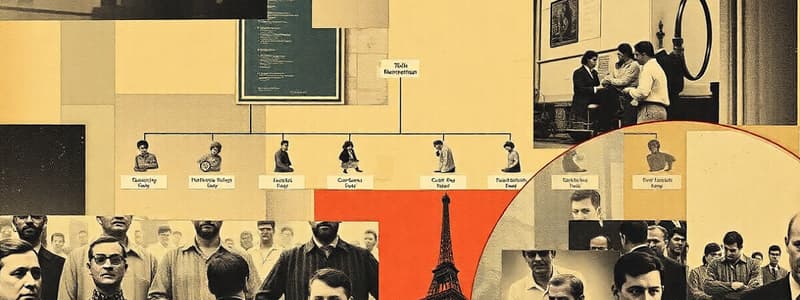Podcast
Questions and Answers
In organizational design, what is the primary goal of 'differentiation'?
In organizational design, what is the primary goal of 'differentiation'?
- To centralize decision-making processes for efficiency.
- To establish clear lines of authority and rank within the organization.
- To create a standardized set of rules and norms.
- To allocate people and resources to organizational tasks and establish authority relationships. (correct)
When decision-making authority is delegated to managers throughout the organization, this is known as:
When decision-making authority is delegated to managers throughout the organization, this is known as:
- Formalization
- Standardization
- Decentralization (correct)
- Centralization
What does 'vertical differentiation' in an organization refer to?
What does 'vertical differentiation' in an organization refer to?
- The specialization of tasks among employees.
- The degree to which an organization relies on formal written rules and procedures.
- The distribution of authority between different levels of the organization. (correct)
- The grouping of organizational tasks to enable specialization.
How does 'horizontal differentiation' contribute to organizational structure?
How does 'horizontal differentiation' contribute to organizational structure?
What is the primary focus of the 'strategic apex' in an organization?
What is the primary focus of the 'strategic apex' in an organization?
Which part of an organization is primarily concerned with converting strategic objectives into operational plans?
Which part of an organization is primarily concerned with converting strategic objectives into operational plans?
Which element of an organization is responsible for conducting the activities necessary to deliver outputs?
Which element of an organization is responsible for conducting the activities necessary to deliver outputs?
What is the main function of the 'Technostructure' within an organization?
What is the main function of the 'Technostructure' within an organization?
What type of activities are typically carried out by the 'Support Staff' in an organization?
What type of activities are typically carried out by the 'Support Staff' in an organization?
Which of Mintzberg's configurations is characterized by centralized power and minimal technostructure?
Which of Mintzberg's configurations is characterized by centralized power and minimal technostructure?
What organizational structure is known for its highly formalized procedures and centralized decision-making?
What organizational structure is known for its highly formalized procedures and centralized decision-making?
In which of Mintzberg's configurations do highly trained professionals have significant control over their work?
In which of Mintzberg's configurations do highly trained professionals have significant control over their work?
What is a key characteristic of a 'Divisional Organisation'?
What is a key characteristic of a 'Divisional Organisation'?
Which type of organizational configuration is best suited for creativity and innovation, with a decentralized structure?
Which type of organizational configuration is best suited for creativity and innovation, with a decentralized structure?
In the context of organizational design, what does 'formalization' refer to?
In the context of organizational design, what does 'formalization' refer to?
What is the primary focus of 'regulated control flows' within an organization?
What is the primary focus of 'regulated control flows' within an organization?
What is the main purpose of 'regulated staff information flows' in an organization?
What is the main purpose of 'regulated staff information flows' in an organization?
Which type of organizational decision is described as being taken routinely and executed quickly?
Which type of organizational decision is described as being taken routinely and executed quickly?
How do 'administrative decisions' differ from 'strategic decisions' in organizational design?
How do 'administrative decisions' differ from 'strategic decisions' in organizational design?
Which of the following best characterizes 'Ad Hoc' decisions in the context of organizational design?
Which of the following best characterizes 'Ad Hoc' decisions in the context of organizational design?
What is the main purpose of 'job specialization' as a design parameter?
What is the main purpose of 'job specialization' as a design parameter?
Which design parameter involves grouping employees together based on specific tasks to coordinate work?
Which design parameter involves grouping employees together based on specific tasks to coordinate work?
What does 'span of control' refer to as a design parameter?
What does 'span of control' refer to as a design parameter?
Why is 'behavior formalization' important in organizational design?
Why is 'behavior formalization' important in organizational design?
Which design parameter defines the level at which decision-making occurs within the organization?
Which design parameter defines the level at which decision-making occurs within the organization?
Flashcards
Organizational structure
Organizational structure
Dividing work into various tasks and coordinating them to achieve organizational goals.
Mutual Adjustment
Mutual Adjustment
Coordinating work by informal communication and understanding between individuals.
Direct Supervision
Direct Supervision
Coordination achieved through direct oversight and instruction.
Standardization of Work Processes
Standardization of Work Processes
Signup and view all the flashcards
Standardization of Work Outputs
Standardization of Work Outputs
Signup and view all the flashcards
Standardization of Worker Skills
Standardization of Worker Skills
Signup and view all the flashcards
Strategic Apex
Strategic Apex
Signup and view all the flashcards
Middle Line
Middle Line
Signup and view all the flashcards
Operating Core
Operating Core
Signup and view all the flashcards
Technostructure
Technostructure
Signup and view all the flashcards
Support Staff
Support Staff
Signup and view all the flashcards
Simple Structures
Simple Structures
Signup and view all the flashcards
Machine Bureaucracy
Machine Bureaucracy
Signup and view all the flashcards
Professional Organization
Professional Organization
Signup and view all the flashcards
Divisional Organization
Divisional Organization
Signup and view all the flashcards
Adhocracy
Adhocracy
Signup and view all the flashcards
Centralized
Centralized
Signup and view all the flashcards
Decentralized
Decentralized
Signup and view all the flashcards
Differentiation
Differentiation
Signup and view all the flashcards
Vertical Differentiation
Vertical Differentiation
Signup and view all the flashcards
Horizontal Differentiation
Horizontal Differentiation
Signup and view all the flashcards
Regulated control flows
Regulated control flows
Signup and view all the flashcards
Operating Work Flow
Operating Work Flow
Signup and view all the flashcards
Regulated Staff Information Flows
Regulated Staff Information Flows
Signup and view all the flashcards
Work Specialization
Work Specialization
Signup and view all the flashcards
Study Notes
- Organizational Theory
- Professor: Ivonne P. Cadavid
- BUS 358E
Organizational Structure and Design
- Introduction
- Coordination in 5 parts
- The Organization in 5 parts
- Minzberg's Organizational Configurations
- The Organization as a System of flows
- Design Parameters
Introduction
- Every organized human activity requires division of labor and task coordination
- Organizational structure the formal system of task and authority relationships that control how people coordinate
Coordination in Five Parts:
- Mutual Adjustment
- Direct Supervision
- Standardization of Work Processes
- Standardization of Work Outputs
- Standardization of Worker Skills
Organization in Five Parts:
- Strategic Apex: Top management ensures mission adherence and manages environment relationship
- Middle Line: Group of managers convert apex plans to operational plans
- Operating Core: Carries out activities to deliver outputs
- Technostructure: Analysts standardize job skills like HR, Training, Finance
- Support Staff: Administrative functions that contribute to overall effectiveness, like PR, legal, and R&D
Mintzberg's Organizational Configurations:
- Simple Structures
- Machine Bureaucracy
- Professional Organization
- Division Organization
- Ad-Hocracy/ Idealistic Organization
Centralized and Decentralized Organizations
- Centralized: Authority to make important decisions at the top
- Decentralized: Authority delegated to managers
Differentiation
- Differentiation: process the organization allocates people and resources to organizational tasks
- Establishes the task and authority relationships that allow it to achieve its goals.
- Vertical Differentiation: Distribution of authority between levels
- Horizontal Differentiation: Grouping of tasks to enable employee specialization
Division of labor
- Division of Labor: Process of establishing and controlling specialization
Organizational Roles
- Organizational role: Behavior required for a position in the organization
Authority
- Authority: Power to hold people accountable and make organization decisions
Hierarchy
- Hierarchy: Classification of employees based on authority and rank
Standardized and Formalized Organizations
- Standardized: Defined by rules and norms
- Formalization: Written rules/procedures to standardize operations
Division of labor
- Division of Labor: Establishing / controlling specialization degree
Organic and Mechanistic Structures
- Organic structures: Promote flexibility for quick adaptation
- Mechanic structures: Designed for predictable and accountable behavior
Characteristics of Simple Structures:
- Centralized power from strategic apex
- Little to NO technostructure
- Few support staffers
- Loose labor division
- Low differentiation
- Small managerial hierarchy
Characteristics of Machine Bureaucracy:
- Very formalized procedures & communication
- Centralized decision-making
- Functional task grouping
- Clearly defined jobs
- Tight vertical structure
- Examples: Large scale car manufacturing plants, government
Characteristics of Professional Organization:
- Bureaucratic
- Relies on highly trained professionals that demand control
- High specialization
- Decentralized decisions
- Clear authority lines
- Standardized procedures
- Examples: Schools, Universities, law firms and hospitals
Characteristics of Divisional Organization
- Organization with different product lines & business units
- Decentralized decisions
- Has division structures
- Central headquarters supporting autonomous divisions
- Multinational corporations are examples
Characteristics of Adhocracy
- Organic structure with decentralized power
- Specialists forming multi-disciplinary teams
- Non-standardized
- Lack of structured coordination to promote creativity
- Pharmaceutical and tech industries are examples
Organization as a System of Flows:
- Shows positions in organization, groups, & authority flow
- Interconnected through flows of authority, work materials, information, & decisions
THREE DISTINCTION FLOWS IN A REGULATED SYSTEM:
- Operating Work Flow: materials and information in combinations; input, processing and output functions
- Regulated Control Flows: regulates vertical flows; chain of authority
- Regulated Staff Information Flows: Communication flow between line and staff; purpose to feed the staff information and advice
The Organizational Design Process:
- Operating decisions: Routine and quick decisions
- Administrative decisions: guide/coordinate operating decisions
- Strategic decisions: Significant impact; least routine
- Ad Hoc: Mix of decision types.
Design Parameters:
- Job Specialization: division of labor
- Behavior formalization: standardization of work content
- Training/Indoctrination: Standardization of skills
- Vertical vs. Horizontal decentralization
- Unit Grouping: Direct supervision, admin division, formal authority, regulated flows, informal communication
- Unit size: system of informal communication, direct supervision
- Planning/control systems: Standardization of outputs
- Liaison devices: informal communication
- Work Specialization: assigns each worker to a task
- Departmentalization/compartments: groups employees to coordinate
- Formalization: Specifies roles within company
- Centralization vs. Decentralization: decision-making level
- Span of Control: Subordinates per manager
- Chain of Command: Hierarchy
Studying That Suits You
Use AI to generate personalized quizzes and flashcards to suit your learning preferences.




